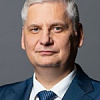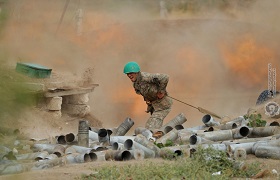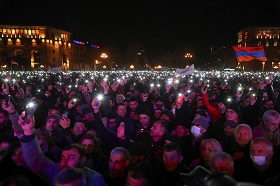The unrecognized Nagorno-Karabakh Republic (NKR) has declared its self-liquidation. A respective decree was signed by Samvel Shahramanyan, the president of this de facto entity. “It has been decided to disband all state institutions as well as bodies under departmental subordination until January 1, 2024,” the document reads. And while NKR is a self-proclaimed republic, whose independence has not been recognized by any nation, including Armenia, the very style of this self-liquidation decree is painfully reminiscent of the famous Belovezha Accords.
In both the former and the latter cases, the document is the consequence rather than the cause of complex ethno-political and international processes. Nagorno-Karabakh was one of the triggers of the Soviet collapse, while the referendum on the NKR formation took place two days after the meeting in Viskuli, which not only put an end to the Soviet Union, but also changed the world.
Self-dissolution of an unrecognized republic can hardly be seen as a significant event that fundamentally changes the international agenda. But the situation in the Caucasus is undergoing serious changes right before our eyes, with consequences certainly extending far beyond the framework of this chronic ethno-political conflict.
Russia is extremely interested in unblocking transport communications and a peace treaty through its decisive mediation. But Turkey (which today feels itself a beneficiary in the Caucasus) benefits from the “corridor logic”, which will connect not only Nakhichevan with the regions of western Azerbaijan, but also the two Turkic allied countries. Of course, Ankara and Baku would prefer a corridor that would pass through today’s Armenian territory, but without Yerevan’s effective control (the question of formulas is secondary here).
Not only the Armenian leadership but Iran, too, do not agree with this approach, because Iran fears robust pan-Turkism along its own borders. Hence Tehran’s growing interest in what transpires in southern Armenia. The Islamic Republic does not recognize self-proclaimed entities (this applies not only to the NKR, but also to Abkhazia and South Ossetia). However, it does not need extraterritorial corridors on Armenian soil, especially since these are put in place under pressure from Ankara and Baku.
The agenda of the peace treaty is not so simple either. Formally, Russia and the West have no fundamental disagreements on this issue as Moscow, Brussels and Washington support the territorial integrity of Azerbaijan. However, after the SMO in Ukraine, the OSCE Minsk Group stopped operations and the unique interaction on the Karabakh track ceased. Now, Russia and the West see each other as rivals, while the peace treaty between Baku and Yerevan is looked upon as a means to minimize each other’s influence in the Caucasus region.
And last but not least, Azerbaijan solved the Karabakh problem by force, not at the negotiating table. One can find thousands of arguments in favor of the premise that the Armenian side had been shirking concessions, merely imitating the negotiation process for many years. But the fact remains that brute force prevailed. This opens horizons for new demands on Baku’s part, whereas Yerevan suffered dangerous traumas and their treatment is accompanied by high risks and unpredictability. Thus, in case of any change in the military and political balance, there is a risk of revision or even breaking of the new status quo, if not by the parties to the conflict directly, then by some external actors.
The unrecognized Nagorno-Karabakh Republic (NKR) has declared its self-liquidation. A respective decree was signed by Samvel Shahramanyan, the president of this de facto entity. “It has been decided to disband all state institutions as well as bodies under departmental subordination until January 1, 2024,” the document reads. And while NKR is a self-proclaimed republic, whose independence has not been recognized by any nation, including Armenia, the very style of this self-liquidation decree is painfully reminiscent of the famous Belovezha Accords.
In both the former and the latter cases, the document is the consequence rather than the cause of complex ethno-political and international processes. Nagorno-Karabakh was one of the triggers of the Soviet collapse, while the referendum on the NKR formation took place two days after the meeting in Viskuli, which not only put an end to the Soviet Union, but also changed the world.
Self-dissolution of an unrecognized republic can hardly be seen as a significant event that fundamentally changes the international agenda. But the situation in the Caucasus is undergoing serious changes right before our eyes, with consequences certainly extending far beyond the framework of this chronic ethno-political conflict.
Conflict genesis
The breakdown of the regional status quo in the Caucasus is associated with the September 2023 escalation. In the course of the third Karabakh war (and the shortest, as it lasted two incomplete days), Azerbaijan achieved the strategic goal it had set in the latter days of the unified Soviet state, which is restoring its territorial integrity. However, while recognizing the obvious importance of this event, one should not reduce the analysis of the current state and future trajectories of the Armenian-Azerbaijani conflict to Baku’s successful blitzkrieg.
Fernand Braudel, a famous French historian and a prominent representative of the Annals school, proposed three categories of time for researchers: “long duration” (one century and more), “cyclic (opportunistic) time” (a range of up to 50 years) and “time of events” (focusing on today’s problems) [1]. To get a holistic view of the dynamics of the Armenian-Azerbaijani conflict and, most importantly, to understand the prospects for its resolution, it is necessary to refer not only to “hot” facts relevant “here and now”, but also to the historical events that go back at least to the previous century and a half, which still determine today’s agenda.
Take, for example, the topic of the so-called “Western Zangezur.” Back in 2021, Azerbaijan’s President Ilham Aliyev said: “Western Zangezur is currently under Armenian control. But due to the Zangezur corridor that was carved out, we’d certainly use it to return our citizens to the land of their ancestors.” On September 25, 2023, while receiving his ally, Turkish President Recep Tayyip Erdogan, in the city of Nakhichevan, Aliyev declared that this exclave was “the ancient edge of Azerbaijan,” separated from the main part of the country by the Soviets. Hence the need to restore the broken justice.
It has become a kind of conventional wisdom to speak of the Armenian-Azerbaijani conflict as a peculiar trigger for the collapse of the USSR. Indeed, the conflict showed the inability of the Soviet leadership to prevent ethno-territorial disputes as well as effectively extinguish the resulting fires. After the Regional Council of the Nagorno-Karabakh Autonomous Oblast (NKAO) within the Azerbaijani SSR petitioned Moscow, Baku and Yerevan on February 20, 1988 to revise its status and incorporate it into the Armenian SSR, the party and Soviet structures were unable to propose a clear strategy for overcoming the crisis, constantly oscillating between three options: direct control from the center, self-determination of the autonomy and the integrity of the AzSSR. As a result, the intra-state conflict turned into an interstate confrontation involving various external actors (Russia, Iran, Turkey, the U.S. and the European Union).
However, the Armenian-Azerbaijani conflict had its own logic and dynamics. And it would be wrong to consider it only as one of the factors (albeit an important one) of the Soviet collapse. The appeal as of February 20, 1988 did not arise out of nothing. It was based on the traditions of ethno-political confrontation, manifested at least since late 19th century, when nationalist ideas had penetrated the South Caucasus.
It is not quite correct to refer to the Armenian-Azerbaijani conflict as the Nagorno-Karabakh conflict either. Indeed, for the past 35 years Karabakh has been at the heart of this confrontation, and the post-Soviet identities of Armenians and Azerbaijanians were developing through a struggle over this tiny piece of land. But, at different times, conflicts between the two peoples or ethnicities would flare up in Baku, Zangezur, Nakhichevan, and even in the territory of modern Georgia, i.e., outside Nagorno-Karabakh. This was the case in the Russian Empire, in the late Soviet times, and after the collapse of the USSR [2]. Just to remind: the trigger for the second Karabakh war was the clashes in July 2020 on the Armenian-Azerbaijani border about 200 km off the hotbed of the conflict in NKR.
Fighting for land and “coincidence”
The main content of these disputes was (and still is) what Ernest Gellner described as the “overlapping” of ethnic and political units [3]. Taking into account the fact that Armenians and Azerbaijanis had, at the turn of the last two centuries, areas of settlement different from the current ones, generally did not live compactly but were interspersed, the struggle for “coincidence” had a wide geography and took place with the intervention of external players. The Turkish, American or French factor in Karabakh, Nakhichevan and Zangezur did not emerge with the appearance of the political figures like Recep Tayyip Erdogan, Joseph Biden or Emmanuel Macron.
The long-lasting Armenian-Azerbaijani conflict has traditionally been fueled by the maximalist aspirations of the two sides. Their national projects presupposed exclusivity rather than inclusivity, the dominance of one ethnic group rather than their co-existence. This was de facto a matter of establishing “ethnic ownership” of land, its scarcity turning the territorial resource into a crucial factor. During the conflicts of 1918-1920, 1988-1994, and 2020-2023, both Baku and Yerevan sought to secure and consolidate territorial gains. The Armenian side described this thrust as ensuring a “security belt”, while the Azerbaijani side addressed to it as caring for the “corridor”.
It would suffice to review all the key initiatives on this conflict resolution, be they discussions at the Paris Peace Conference of 1919 or the proposals of the OSCE Minsk Group between 1997 and 2020 (“the package approach”, “step-by-step” plans, “common state”, “Madrid Principles” and their various updated modifications), to see that the peace initiatives were mainly put forward by third parties rather than the sides to this ethno-political standoff. Against this background, the proposals of the first Armenian president Levon Ter-Petrosyan emerge as a unique example of pragmatism and readiness for concessions and compromises. But these are so interesting exactly because they are exceptions to the general rule!
Conflict pendulum
What has been the pattern for the pendulum of the Armenian-Azerbaijani conflict that sometimes led to radical changes in the status quo in South Caucasus? First of all, escalations occurred whenever an intra-state conflict would turn into an inter-state one. This was the case during the fall of the Russian Empire in 1918 and during the collapse of the USSR in 1991. Second, the status quo was ensured by the military-political balance of power, which combined the correlated potentials of the opposing parties and external actors. As soon as this fragile balance was to be disturbed, negotiations and diplomatic visits were replaced by renewed hostilities. In 2020 and 2023, Baku raised the stakes, clearly aware of the window of opportunities. The matter regards Moscow refocusing to other directions (Belarus in 2020 and Ukraine after 2022), the EU and the U.S. being interested in co-operation with Azerbaijan as an important energy partner, and Turkey’s growing potential in Eurasia. The mounting contradictions between Russia and the West were also taken into account, which made it impossible for the leaders of the global community to reach any consensus on the conflict resolution.
The path to September 2023 was largely programmed by the contradictory outcomes of the second Karabakh war three years ago. On the one hand, the status quo that had existed for 26 years was shattered at the end of the hostilities. Azerbaijan established its control not only over the seven districts occupied by Armenian forces in 1992-1994, but also reclaimed a significant part of the former NKAO, including the second largest city in this territory called Shusha, along with villages in the Hadrut, Mardakert and Martuni districts. By the beginning of 2021, the total size of land under the control of the unrecognized NKR had decreased fourfold. After the 2020 war, the line of contact between the conflicting sides became longer and more flexible. Since then, the positions of the opponents have been only 30-10 meters apart, whereas the warring parties were separated by hundreds of meters two years ago. Armenia, having lost its so-called “security belt”, gained a new section of the state border with Azerbaijan in the southern regions of Syunik and Gegharkunik.
But, on the other hand, Azerbaijan did not gain a decisive military victory. Its troops were stopped not far from Stepanakert, the capital of the unrecognized NKR. There was no symbolic capture of the last frontier of the Armenian defenses in Karabakh. The infrastructure of the de facto entity, albeit in a territorially reduced form, had been preserved. Financially and economically, it is still supported by Armenia. Moreover, at the end of the second Karabakh war, Armenian armed units were not completely withdrawn from the territory of the unrecognized NKR. The authorities (president, parliament, government), the army and the police of Nagorno-Karabakh continued to function, and even in September 2023 (sic!) the NKR parliament elected a new president, Samvel Shahramanyan, whose signature will now be forever associated with self-liquidation of the unrecognized republic. Be that as it may, foreign politicians visited Karabakh in 2020-2022 (French presidential candidate Valerie Pecresse), and famous billionaire and philanthropist Ruben Vardanyan even heading the republican government for some time.
Yet, Azerbaijan was not ready to accept this new “freezing of the conflict” and, starting in 2021, it began to implement “salami tactics” in relation to Karabakh, cutting off important security and communication nodes from this territory step by step (blocking the Lachin corridor, evacuating Armenian villages around this regional center). The lack of sufficient resources inside the country and outside support forced Yerevan to pursue a policy of geopolitical minimalism. As a result, before September 2023, the Armenian authorities had already recognized Baku’s sovereignty over Nagorno-Karabakh. The last straw was surely Nikol Pashinyan’s idea of “providing international guarantees” for the Karabakh Armenian community. The military escalation of September 19-20, 2023 broke those arrangements as well.
End of history or a new chapter?
Does Karabakh’s self-liquidation mean the end of the conflict? Is the long-awaited peace close at hand? I’d like to give unambiguously positive answers to these questions. But there are some subtle aspects which call for special consideration.
At this point, let’s get back to our initial proposition about defining the conflict as Armenian-Azerbaijani, rather than Nagorno-Karabakh per se. Alongside the status of the NKR, which has finally been removed from the agenda, there is the issue of the exclaves (formally former territories of the Azerbaijani SSR and the Armenian SSR, which in their time found themselves de facto within “foreign republics”). In addition, the issue of demarcation and delimitation of the state border has not been resolved, as it was addressed only during special negotiations.
It should be noted that Azerbaijani forces had already moved deep into Armenia in 2021 in the Sotq-Khoznavar section, covering an area of about 5,400 hectares. Subsequently, a checkpoint was set up there to carry out customs and border control. And, of course, the issue of the so-called “Zangezur corridor”, which had been in “dormant mode” until 2020, but after the change of the military-political status quo reemerged once again, is far from being settled.
Meanwhile, all these issues, alongside the Armenian-Azerbaijani problem, affect the interests of other parties. Russia is extremely interested in unblocking transport communications and a peace treaty through its decisive mediation. But Turkey (which today feels itself a beneficiary in the Caucasus) benefits from the “corridor logic”, which will connect not only Nakhichevan with the regions of western Azerbaijan, but also the two Turkic allied countries. Of course, Ankara and Baku would prefer a corridor that would pass through today’s Armenian territory, but without Yerevan’s effective control (the question of formulas is secondary here).
Not only the Armenian leadership but Iran, too, do not agree with this approach, because Iran fears robust pan-Turkism along its own borders. Hence Tehran’s growing interest in what transpires in southern Armenia. The Islamic Republic does not recognize self-proclaimed entities (this applies not only to the NKR, but also to Abkhazia and South Ossetia). However, it does not need extraterritorial corridors on Armenian soil, especially since these are put in place under pressure from Ankara and Baku.
The agenda of the peace treaty is not so simple either. Formally, Russia and the West have no fundamental disagreements on this issue as Moscow, Brussels and Washington support the territorial integrity of Azerbaijan. However, after the SMO in Ukraine, the OSCE Minsk Group stopped operations and the unique interaction on the Karabakh track ceased. Now, Russia and the West see each other as rivals, while the peace treaty between Baku and Yerevan is looked upon as a means to minimize each other’s influence in the Caucasus region.
And last but not least, Azerbaijan solved the Karabakh problem by force, not at the negotiating table. One can find thousands of arguments in favor of the premise that the Armenian side had been shirking concessions, merely imitating the negotiation process for many years. But the fact remains that brute force prevailed. This opens horizons for new demands on Baku’s part, whereas Yerevan suffered dangerous traumas and their treatment is accompanied by high risks and unpredictability. Thus, in case of any change in the military and political balance, there is a risk of revision or even breaking of the new status quo, if not by the parties to the conflict directly, then by some external actors.
Reference List
1. Braudel F. History and Social Sciences. Long Duration // Philosophy and Methodology of History. Ed. I.S. Kon. M., Progress, 1977. – p. 115-143.
2. Markedonov S.M. Transformation of the Armenian-Azerbaijani Conflict: Historical Experience and Modern State // World Economy and International Relations. 2022, vol. 66 – No. 12, p. 120-130
3. Gellner E. Nations and Nationalism. M., Progress, 1991, 127 pages







